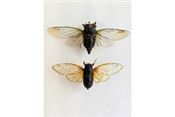Billions Of Cicadas Will Return To Kentucky In Late Spring

Preserved specimens show the difference between the annual cicadas (top) and the periodical
cicadas (bottom). The periodical cicadas are the ones that will be in Kentucky this spring.
Photo by Jonathan Larson, UK extension entomologist.
LEXINGTON, KY.
This May and June, billions of 17-year periodical cicadas will emerge from the ground all across Kentucky, but don’t worry. They will mostly be a noisy irritation, said a University of Kentucky College of Agriculture, Food and Environment entomologist.
“Periodical cicadas are not a pest necessarily, especially of people,” said Jonathan Larson, UK extension entomologist. “They are not going to bite us. They are not going to attack us. They are not inherently toxic to pets. There can be some annoyance with the noise they produce, especially if you are standing right next to them. It’s like standing next to a jet airplane.”
The emerging cicadas this spring are part of Brood X, which is one of the largest groups of cicadas in the U.S. In addition to Kentucky, these cicadas will be present in Michigan, Illinois, Indiana, Ohio, New York, Georgia, Tennessee, North Carolina, Virginia, West Virginia, Pennsylvania, Maryland, New Jersey and Delaware.
While cicadas will be present throughout Kentucky, counties along the Ohio River, state parks and forested areas are expected to see the biggest numbers.
“Normally we see the annual cicadas, which are green and black, but the cicadas emerging this summer are a different species. They are black with red eyes and orange marks on their wings,” Larson said.
“It will be a unique experience. The trees will be very loud this spring. People should get out and try to enjoy them while they are here.”
Kentuckians who have young trees, especially newly transplanted ones that are potential hosts to the bugs, should prepare to protect their trees. Host trees include young oaks and fruit trees.
“Those can be damaged as the female cicadas lay their eggs in their branches,” Larson said. “Getting some netting with holes that are less than one-half-inch wide and wrapping it around the young trees for about six weeks while the insects are out will keep those females from laying their eggs on them.”
When the cicadas emerge from the ground as nymphs, they will molt and leave behind a brittle exoskeleton. ∆